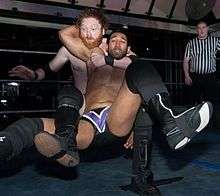Stunner (professional wrestling)

A stunner is a common term in professional wrestling referring to the sitout ¾ facelock jawbreaker maneuver. It was innovated by Mikey Whipwreck who called it the Whipper-Snapper, but it was popularized by Stone Cold Steve Austin, who faced Whipwreck in Extreme Championship Wrestling. The move was named for Austin's Stone Cold Stunner finisher. It involves an attacking wrestler applying a three-quarter facelock (reaching back and grabbing the head of an opponent, thus pulling the opponent's jaw above the wrestler's shoulder) before falling to a seated position and forcing the opponent's jaw (but predominantly the opponent's neck) to drop down on the shoulder of the attacking wrestler. The free hand is sometimes used to hold the top of the head.[1]
Types
Backpack stunner

Also known as a piggyback stunner, in this elevated stunner variation, the opponent is first raised up in a piggy-back position. From here, the attacking wrestler applies a three-quarter facelock and drops down to a seated position while still holding the opponent's head to force them to fall into the stunner. Charlotte Flair used this as her signature move in NXT, the wrestler Ryback also uses this move as a signature move, he calls it the Boulder Houlder. [2]
Diving corkscrew stunner
Ember Moon's version of the stunner is when the wrestler launches themselves off the top rope and does a corkscrew rotation. After completing the corkscrew, whilst still in mid-air the attacking wrestler applies a three-quarter facelock to the opponent whilst falling down to a seated position to complete the stunner. This version is also known as the "O-Face" during Moon's time on the independent circuit as Athena and as the Eclipse in WWE.
Elevated stunner
With an opponent placed on an elevated surface, a wrestler applies a three-quarter facelock and then draws the opponent away, leaving only the opponent's feet over the elevated surface. The wrestler then falls to a seated position so that the opponent is forced to dive forward across the shoulder of the attacking wrestler. This is believed to have more impact due to the angle of which the opponent is dropped. The elevated stunner can also be performed as a double-team move.
Fireman's carry stunner
Also known as the Total Knock Out or TKO for short, this is an elevated stunner variation in which the opponent is first raised over the shoulders of a wrestler in the fireman's carry position. From here, the attacking wrestler throws the legs of the opponent out backwards and drops down to the mat while taking hold of the opponent's head to force them to fall into the stunner. The name originally referred to the cutter variation. The name has since been used to refer to both types.
Forward somersault stunner
A standing variation of the Diamond Dust in which the attacking wrestler first holds an opponent in an inverted facelock before then jumping forwards to somersault over the opponent, landing in a seated position with the opponent's head driven into the wrestler's shoulder.
Front facelock stunner
In this variation, the wrestler first applies a front facelock, before pivoting 180 degrees to bring themselves into the three-quarter facelock position and dropping down to a sitting position, forcing the opponent's jaw to drop down on the shoulder of the attacking wrestler. Jeff and Rebecca Hardy use the variant, also called the Twist of Fate, along with the better known cutter variation.
Inverted suplex stunner
This variation sees the wrestler apply an inverted facelock on an opponent before hooking their tights and lifting them straight up in the air so that they are upside down. The wrestler then lets the opponent's body fall backwards over their shoulder as in an inverted suplex, and when the opponent's feet lands on the mat, the wrestler drops to a seated position to force the opponent's jaw to drop down on the shoulder of the attacking wrestler.
Jumping stunner
Similar in execution to a jumping cutter, this version sees an attacking wrestler crouch in front of the opponent, then jump up and grab the opponent in a three-quarter facelock and drop down into a stunner.
Rolling stunner
This version sees an attacking wrestler first place an opponent (who is in front of them) in an inverted facelock before rolling themselves under the opponent, turning both wrestlers over so that the opponent can be dropped into the stunner. Frankie Kazarian uses this move as a finisher, calling it "Ace of Spades".
Running stunner
Similar in execution to a running cutter, the running stunner is where the attacking wrestler runs to an opponent who is distracted and grab the opponent in a three-quarter facelock and drop down into a stunner
Springboard stunner
This variation sees the attacking wrestler jump onto the ropes, followed by the wrestler springboarding off the ropes back into the opponent and hitting the stunner. The move has been innovated by John Cena. There is also a corkscrew variation that is used as a finisher by Flip Gordon, calling it the Star-Spangled Stunner.
Stone Cold stunner
The true Stone Cold stunner as popularized and stated by Steve Austin, always involves a boot to the gut before the 3/4 facelock is applied. [3]
Tilt-a-whirl stunner
Often used as a counter to the tilt-a-whirl backbreaker, this variant sees the attacking wrestler in the Tilt-a-whirl position, but instead of being lifted and slammed onto a knee or into the mat, the attacker reaches back and applies a three-quarter facelock before falling to a seated position, with the opponent's jaw impacting with the shoulder of the wrestler. British independent wrestler Lana Austin uses this move as a finisher, calling it Kiss of Death.
Vertical suplex stunner
This elevated stunner first sees the attacking wrestler apply a front facelock, hook the opponent's near arm over their shoulder and lift them as for a standard vertical suplex. However, in mid-move, the attacking wrestler forces the opponent to turn 180 degrees and then apply the three-quarter facelock, forcing the opponent to drop down with their jaw across the attacking wrestler's shoulder as they fall to a seated position to hit the stunner. Innovated and popularized by Masato Tanaka as the Shotgun Stunner. R-Truth uses this move too, he call it the Truth or Consequences
Wheelbarrow stunner
Often used as a counter to the wheelbarrow facebuster, this variant sees the attacking wrestler in the wheelbarrow position, but instead of being lifted and slammed into the mat, the attacker reaches back and applies a three-quarter facelock before falling to a seated position, with the opponent's jaw impacting with the shoulder of the wrestler.[4]
See also
Notes
- ↑ "the 50 coolest maneuvers of all time - Stunner". WWE. 2014-02-21. Retrieved 2014-05-04.
- ↑ "Self-Assumed Foresight: The Futures of The First Eight NXT Rookies". Bleacher Report. Retrieved 2010-08-15.
- ↑ https://www.youtube.com/watch?v=Kpis7-PWObg
- ↑ Casadora Stunner